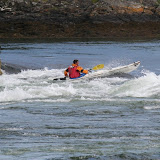
Recently some enthusiast new members joined local kayakclub KV Wyrda. Together they form a group that is eager to learn - a pleasure to work with! Yesterday-evening I found myself teaching basic kayak-"control and safety"-skills to Maxime, Hetty, Nienke and Natascha in Reeuwijk. It was a fun and wet session: the water is warm and the weather is fine. All had a good laugh. The ladies were paddling the new club kayaks - type Wilderness Systems Tsunami 120. KV Wyrda expanded the fleet with these boats last month, to offer beginners a comfortable and stable, confidence-giving kayak to get into the sport.
I never paddled the Tsunami120 and actually only knew the boat from the pictures on the web. The beginners in the club have been paddling the Tsunamis for some weeks now. I was told that most like this boat because it's stable, comfortable and tracking well (on the placid waters around Woerden). Some of the beginners however, prefer the older club-kayaks because they are faster and paddle more effortless. Because the (PE-)Tsunami are more robust than the other club-kayaks and because I didn't plan to cover long distances with the group anyhow, I asked yesterday to take the Tsunamis to Reeuwijk.
At the end of the session I changed kayak with Nienke - It's important for a coach to place himself in the position of his pupils (in sport also physical) to understand what the pupil is feeling. It's fine to demonstrate kayak skills in the trusty seakayak, but does it work in a recreational-boat? I wanted to experience myself what the Tsunami feels like. Is this boat suited to learn leaning and edging? And in next lessons: for bracing and rolling? To be honest: my expectations weren't very high. The Tsunami is a short, wide kayak with a high deck and a padded seat with backrest that looks like an armchair. Perhaps the perfect boat for kayak-fishing or sunbathing, but not the first design that comes in my mind when I think about a kayak to learn people an active kayak-technique. As I slid in the kayak I noticed that I had underestimated the Tsunami seriously. The outfitting of the kayak invites to an active seating position and gives good support. It's easy to edge, it responds well and to my biggest surprise: it's unbelievable easy to roll. I was impressed in the five minutes I was paddling and rolling the Tsunami! This morning I went back to the clubhouse for a closer look and an ample rolling session.
The Tsunami is the "living proof" that a seating position with good contact/control is far more important than finesses in hull design. Despite the wider and flatter hull the Tsunami rolls easier than many (older) sea- ww- and greenlandkayak I paddled before. I am sure this is due to the modern ergonomic cockpit design that is incorporated in the Tsunami. Characteristics of this design are primary a wide and high position of the knees, combined with a low seat and well contoured thigh grips. The roomy seat brings also some advantage in rolling - some space to shift side to side is good. This "knees wide and high"-design has become standard in modern WW- and rodeo-kayaks - and is also getting more common in seakayaks: examples are the NDK Romany, the Explorer HV and the Rockpool Alaw - kayaks with a seating position that comes close to this principles . It's no coincidence that all these boats are known as good rollers (btw: there are surely more recent seakayaks with a similar cockpit design - these are such boats I know from personal experience...). It's a totally other philosophy than that behind the design of Greenland rolling kayaks (low deck, stretched legs, padded Masik (deck beam), snug fit).
The Greenland design is proven, for over thousand years. It's good - I won't detract from that. The "knees high and wide"-idea is perhaps ten years old. It shows that there is always potential in development -WW and rodeo ideas contribute to modern seakayaking.
It was fun Greenland rolling in the Tsunami. Looking at the pictures, you might think the high backrest hinders with layback rolls, but it doesn't: the backrest has a recline feature and tilts backwards when you lean on it. Forward endings rolls are no issue. The only downside with the clubkayaks is the miserable nylon sprayskirt. The sprayskirt looks tough, but gets loose every time you roll. So you end up rolling with an open cockpit full of water.
 The kayaks are swapped for bikes and internet access will be scarce - therefore it's going to be a bit quiet on this kayakblog the next weeks. In the middle of August I'll be back on the water again! See you!
The kayaks are swapped for bikes and internet access will be scarce - therefore it's going to be a bit quiet on this kayakblog the next weeks. In the middle of August I'll be back on the water again! See you!











